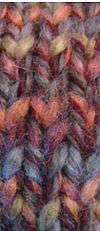Short row (knitting)

In knitting, a short row is a row that is not fully knitted; the work is turned before reaching the end of the row. Just before the work is turned, the yarn is generally passed around the next unknitted stitch to prevent a hole from forming at the turning point.
The typical bobble provides a simple illustration of short rows. The extra bobble stitches are knitted back and forth several times without knitting the entire row.
Short rows may be used to bend a flat ribbon of knitting, which requires more fabric on the outside of the curve than on the inside of the curve. Short rows introduced on the outside edge will cause the ribbon to bend.
Similar to increases and decreases, a common use for short rows is in shaping, e.g., in making sock heels or French darts near the bust point. Short rows introduce extra rows ("courses") of knitting, whereas increases introduce extra columns ("wales"). In principle, any shaping possible with other increase/decrease method is also possible with short rows. However, such shaping is often harder to visualize.
Short rows are also useful in making more attractive bound off edges over multiple rows, e.g., in a raglan armhole, in a sleeve cap, or over a shoulder slant. The stitches to be bound off can be "held in reserve" on the knitting needles without being knitted using short rows. At the end, all the stitches can be bound off at once, producing a more continuous edge without the typical "ladder" of decreases.
References
Gibson-Roberts, Priscilla A. (2004). Knitting in the Old Way. Colorado: Nomad Press.
Hiatt, June Hemmons (1988). The Principles of Knitting. New York: Simon and Schuster. pp. 175–182.
Stanley, Montse (1999). Knitter's Handbook. Pleasantville, NY: Reader's Digest Association.
